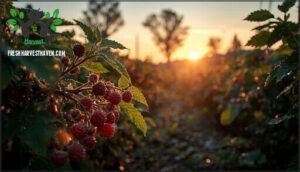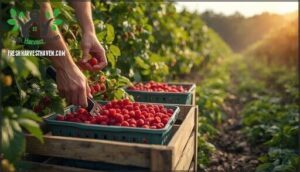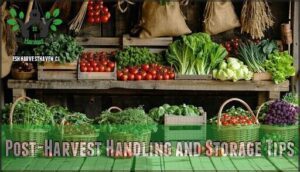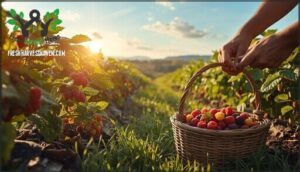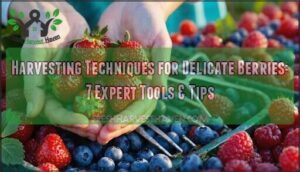This site is supported by our readers. We may earn a commission, at no cost to you, if you purchase through links.
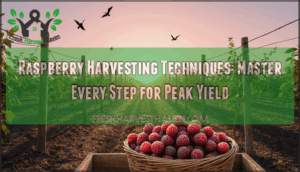
Raspberry harvesting techniques separate profitable operations from those that watch margins evaporate with every bruised drupelet. The difference between a firm, jewel-toned berry that commands top dollar and a leaking mess isn’t luck—it’s mastering the mechanics of touch, timing, and temperature control that transform fragile fruit into consistent revenue.
Table Of Contents
Key Takeaways
- Growers lose 20–30% of raspberry crops in the final 60 seconds of harvest due to improper handling—mastering gentle touch, timing, and temperature control transforms fragile fruit into consistent revenue.
- Early morning harvest in dry conditions, combined with rapid cooling to 0–1°C within 1–2 hours, extends shelf life to 5–7 days and prevents the mold and bruising that destroy marketability.
- Variety selection determines harvest strategy—summer-bearing raspberries deliver concentrated 4–6 week harvests while everbearing types extend picking windows to 8–10 weeks with 25–30% higher cumulative yields.
- Pruning density of 10–12 canes per meter, soil pH between 5.5–6.5, and strategic nitrogen application (56–90 kg/ha yearly) create the foundation for high-yield harvests that last season after season.
Selecting The Best Raspberry Varieties
Your harvest success starts long before you pick your first berry. The variety you choose determines everything from when you’ll harvest to how much fruit ends up in your basket.
Let’s break down the key factors that separate growers who struggle from those who consistently pull in peak yields.
Summer-Bearing Vs. Everbearing Types
Your raspberry variety selection shapes your entire harvest strategy—summer-bearing raspberries deliver one concentrated crop over 4–6 weeks on second-year canes, while everbearing types extend harvest duration across 8–10 weeks with fruit on first-year growth.
Everbearing raspberries boost cumulative yields by 25–30% in managed systems, though summer-bearing varieties often produce larger berries.
Cane management differs dramatically: summerbearing raspberries require careful floricane removal post-harvest, whereas everbearing types offer simplified annual mowing for enhanced fall fruit yield.
Understanding the raspberry yield comparison is essential for maximizing productivity in your raspberry harvest.
Climate and Soil Compatibility
Beyond variety choice, your region’s climate zones and soil composition determine whether those canes will thrive or struggle. Raspberries excel in USDA Hardiness Zones 4–8, where daytime temperatures hover between 70–75°F. Your soil pH should test between 5.5 and 6.5—below 5.0, manganese toxicity weakens canes. Loamy soils with 4–6% organic matter support root oxygenation, while proper drainage prevents waterlogging that cuts oxygen diffusion by 80% in just 24 hours. Microclimate effects matter too: slopes facing northeast delay bud break, dodging late frosts, and windbreaks reduce moisture loss by 30%. For essential growth, understanding raspberry planting techniques is vital.
- Test soil temperature and water table depth before planting to avoid root rot and nutrient lockout in cold or saturated conditions
- Amend heavy clay with coarse sand and compost to hit that critical drainage threshold and prevent compaction above 1.6 g/cm³ bulk density
- Monitor local microclimates near structures for 2–3°C temperature boosts that accelerate early growth and extend your harvest window
Disease Resistance and Yield Potential
Once you’ve aligned climate and soil, locking in resistant cultivars shields your investment from devastating losses. Raspberry Bushy Dwarf Virus alone slashes marketable fruit by up to 40% in susceptible raspberry varieties, while root rot can collapse entire fields and cut yield in half.
Disease-resistant raspberry varieties protect your investment—viruses and root rot can slash yields by 40–50%, but resistant cultivars maintain strong production and double shelf life
Breeding methods now use marker-assisted selection and SNP mapping to identify genetic sources of resistance early—’Latham’ delivers rock-solid root rot defense, and backcross lines from R. occidentalis drop grey mold waste to just 1.1 out of 10 fruit.
Disease-resistant selections maintain 5+ t/ha yields and double shelf life, proving variety deployment rooted in pest identification and control directly maximizes raspberry harvest and profit.
Preparing for Raspberry Harvest
Getting your raspberries off the cane at the right moment separates a bumper crop from a missed opportunity. You can’t just wander into the patch whenever it’s convenient and expect premium fruit—timing, ripeness, and weather all play their part.
Here’s what you need to nail down before you start filling containers.
Recognizing Ripeness Indicators
Reading ripeness indicators is your ticket to harvesting at the exact right moment. Look for a deep, uniform red color without green or white patches—that signals anthocyanin development and peak sugar levels around 7% Brix.
Ripe raspberries slip off the core with barely a tug, and their firmness shifts from firm to yielding.
Check that flower remnants have dried and fallen away, confirming full maturity and supreme fruit quality.
Ideal Harvest Timing and Frequency
Timing is everything when you’re aiming for raspberry yield optimization. Harvest every two to three days during peak season to capture berries at their prime—this keeps pace with the uneven ripening that’s typical in raspberry clusters.
When temperatures spike, shift to daily or every-other-day picking to prevent overripe fruit and insect damage.
Stagger summer-bearing and fall-bearing varieties to extend your seasonal timing from June through October in many regions.
Weather and Moisture Considerations
Without careful moisture management and climate adaptation, you’ll lose harvests before fruit ever reaches your basket. Wet-picking conditions slash shelf life from three days to just one—rainfall promotes mold that ruins berries within hours if surfaces don’t dry first. Wait until morning dew evaporates before harvesting to prevent fungal growth and bruising.
Drip irrigation and mulching maintain ideal soil moisture without waterlogging fruit tissue, while raised beds improve drainage during heavy rainfall impact, protecting roots from rot that devastates yields.
Step-by-Step Raspberry Harvesting Techniques
You’ve done the prep work—now it’s time to master the actual harvest. The way you pick makes all the difference between plump, perfect berries and a bucket of mush.
Let’s break down the techniques that’ll help you pull off a perfect raspberry harvest.
Gentle Picking Methods
The secret to peak yield lies in how you handle each berry—apply 1.4 to 2.8 N of force, and you’re golden. Gentle twisting between thumb and forefinger is your best move for soft picking, achieving 90% success with minimal damage during raspberry harvesting techniques.
- Roll, don’t pull: Gently twist ripe berries to preserve drupelets and reduce skin rupture
- Read the color: Deep, uniform red signals easy fruit detachment—lighter tones demand more caution
- Keep force low: Staying below 2 N during berry picking and handling cuts crushing risk by up to 50%
Using Proper Tools and Containers
Your tool selection and container designs make or break harvest efficiency when you’re out there harvesting raspberries. Hand picking remains the benchmark for fresh-market berries, while mechanical harvesters work well on larger operations exceeding five acres.
Use shallow containers with ventilation systems and vented walls—they boost airflow and trigger rapid cooling methods that preserve quality.
Food-safe HDPE harvest tools resist cracking during intensive use, and ergonomic grips keep you comfortable during long sessions, directly improving your raspberry harvesting techniques.
Avoiding Bruising and Crushing
Bruising starts the moment you grip too hard—that delicate skin ruptures, and your harvest handling determines whether berries reach the table or the compost. Train your fingers to use a gentle turning motion instead of pulling, cutting detachment force by 40% and protecting those fragile drupelets.
Keep containers shallow, stacking no more than three to four layers, because crushing weight from overfilled bins ruins fruit firmness and triggers decay. Berry protection depends on your touch and packing discipline throughout postharvest care.
Post-Harvest Handling and Storage Tips
You’ve picked your berries at peak ripeness—now it’s time to protect that hard-earned harvest. How you handle raspberries in those first few hours can make or break their quality and shelf life.
Here’s what you need to know about cooling, storage, and preservation methods that’ll keep your berries in top condition.
Cooling and Storing Raspberries
Once you’ve picked your raspberries, the clock starts ticking—every hour you wait can cost you a full day of shelf life. Rapid cooling is your secret weapon for fruit preservation. Get those berries into cold storage within 1–2 hours of harvest, targeting 0°C to +1°C with 90–95% humidity.
Here’s your game plan for proper raspberry storage:
- Use forced-air cooling to drop temperatures in under an hour—it’s 75–90% faster than room refrigeration methods
- Never let your berries dip below –0.6°C, or you’ll trigger freezing damage
- Keep temperature swings under ±1°C to prevent condensation and berry storage disasters
- Store in shallow containers that allow air circulation around each fruit
- Expect 5–7 days of peak marketability when your raspberry cooling system hits the mark
Skip the washing until you’re ready to eat—moisture accelerates spoilage faster than anything else.
Preventing Mold and Spoilage
Cooling alone won’t save your crop—humidity management and fruit sanitation are what separate thriving berries from moldy disasters. Keep relative humidity at 90–95% to maintain firmness without tipping into mold territory above 93%. Remove damaged berries immediately; they spread millions of spores that’ll infect healthy fruit within hours. Wash harvest containers with 70% ethanol to slash microbial load by 85%.
Here’s your spoilage control arsenal:
| Strategy | Impact on Mold Prevention |
|---|---|
| Field sanitation (remove rotting fruit) | 60% reduction in airborne spores |
| Sort damaged berries before cooling | 20–30% less postharvest decay |
| Modified atmosphere packaging (5–10% O₂) | 40% slower mold growth |
| Cinnamon oil treatments | 52–93% visible mold reduction |
| Harvest in dry weather | 50% lower spore germination |
Never stack berries deep—bruising accounts for 80% of fungal infections, and cross-contamination happens fast in crowded containers.
Short-Term Vs. Long-Term Preservation
Once you’ve stopped the immediate decay clock with proper cooling, your next move hinges on how long you need those berries to last. Refrigeration methods at 32–34°F give you 1–3 days of peak quality—perfect for roadside stands or quick consumption. Freezing techniques at −18°C lock in nutrients for up to a year, with isochoric methods preserving texture better than standard freezers. Dehydration processes like freeze-drying extend shelf life to 30 years but reduce vitamin C by 80–99%.
Match your storage solutions to your timeline: short-term preservation demands immediate cold storage, while long-term raspberry harvesting techniques require freezing or dehydration to optimize fruit preservation and shelf life extension.
Maintenance Practices for High-Yield Harvests
Harvesting raspberries is just the first step—keeping your plants productive year after year takes consistent care. The right maintenance moves directly impact your yields, fruit quality, and how long your patch stays profitable.
Here’s what you need to do to keep those canes pumping out berries season after season.
Pruning for Optimal Production
Your pruning strategy determines whether you harvest buckets or barely fill a basket. Cane management is the foundation—maintain 10 to 12 canes per meter of row for the sweet spot between yield and fruit size. Cornell research confirms this density maximizes large fruit production while preventing disease.
Smart Raspberry Pruning Techniques for Yield Optimization:
- Keep full cane length intact—60-inch canes outproduce 36-inch ones markedly, boosting harvest efficiency by up to 12% under ideal conditions.
- Prune raspberry canes in late winter—timing matters, with spring adjustments improving recovery from winter damage by 22%.
- Remove weak or diseased wood immediately post-harvest—cutting pathogen carryover by 30% protects next season’s fruit quality.
- Skip primocane tipping unless necessary—it increases labor costs 10–15% and complicates picking despite slight yield gains.
- Combine pruning with trellising—supported canes improve uniformity and boost efficiency 20% over free-standing growth.
These raspberry pruning methods aren’t suggestions—they’re your blueprint for dominating harvest season year after year.
Watering and Mulching Strategies
Your watering and mulching strategies dictate harvest power. Raspberry plants demand 1–1.5 inches of water weekly, spiking to 2 inches during hot stretches—drip irrigation delivers this precisely while slashing disease risk. Maintain soil moisture between 44–58% from bud break through harvesting for maximum crop management efficiency.
Black polyethylene mulch materials dominate yield trials, boosting production 40% over bare soil by locking in water efficiency and crushing weed competition.
Container raspberries? Water daily when heat hits hard.
Fertilization and Soil Health
Soil health dictates whether you harvest buckets or crumbs. Test your soil annually and dial pH to the golden 5.5–6.5 range—anything below 5.0 starves canes, while alkaline soil above 7.0 triggers iron deficiency.
Fertilize raspberry canes strategically:
- Apply 56–90 kg/ha nitrogen yearly, adjusting for organic matter levels and plant age
- Incorporate phosphorus (30 kg/ha) and potassium (60 kg/ha) during autumn before spring planting
- Split potassium across growth stages—15–30 kg/ha at leaf emergence, ramping to 50 kg/ha during fruit growth
- Inoculate with beneficial bacteria like Pseudomonas and Arthrobacter to crush soilborne pathogens and boost nutrient cycling
Organic matter above 3% turbocharges microbial balance and water retention, turning soil testing and analysis into your yield insurance policy.
Frequently Asked Questions (FAQs)
How do you protect raspberries from birds and pests?
Don’t let bird deterrents become a wild goose chase—effective pest control demands smart crop protection. Netting methods offer near-complete exclusion, blocking birds and pests like spotted wing drosophila.
You’ll boost biological controls through beneficial insects, while proper pruning reduces pest and disease management headaches.
Combining physical barriers with IPM strategies gives you commanding raspberry pest and disease control that delivers tangible raspberry health benefits.
Can you harvest raspberries in the rain?
Skip harvesting raspberries in the rain—wet berries bruise easily, invite mold within hours, and compromise marketability by up to 25%. Moisture damage reduces harvest efficiency and shelf life, making rainy day strategies critical for protecting your ripe raspberry harvest.
Whats the best time of day to harvest?
Early morning harvest timing gives you the edge—cooler temperatures firm up berries, reducing bruising and water loss.
You’ll preserve peak flavor and extend shelf life when picking during those crisp, dry hours before the sun heats up your patch.
How long does raspberry harvest season typically last?
Raspberry harvest season spans 3 to 6 weeks for summer-bearing types, usually peaking in July. Everbearing varieties extend your window to 2-3 months with dual harvests in early summer and fall.
Climate factors and regional variations shape seasonal timing—cooler areas concentrate harvest in one month, while warmer regions maximize yield with irrigation techniques.
Should you wear gloves when picking raspberries?
Absolutely wear gloves when picking raspberries—those thorny canes don’t mess around.
Thin, flexible gloves protect your hands from puncture wounds and infections while maintaining the dexterity you need for gentle fruit handling without bruising delicate drupelets.
Conclusion
What’s the point of perfecting every other variable if your raspberry harvesting techniques fail in those final sixty seconds? Touch matters more than technology here—your fingertips determine whether berries hit the cooler intact or turn to mush before lunch.
Master the gentle roll, pre-chill your containers, and harvest when dew evaporates but heat hasn’t peaked. You’ve controlled the growing season; now control the moment that converts cultivation into cash. Precision at harvest isn’t perfectionism—it’s the difference between profit and compost.
- https://journals.ashs.org/downloadpdf/journals/jashs/98/5/article-p432.pdf
- https://ers.usda.gov/sites/default/files/_laserfiche/publications/44764/ERR-106.pdf
- https://www.centralstate.edu/news/central-state-university-researchers-students-harvest-raspberries-campus
- https://www.ishs.org/ishs-article/60_4
- https://farmonaut.com/usa/raspberry-yield-2025-ndvi-soil-data-pacific-nw

